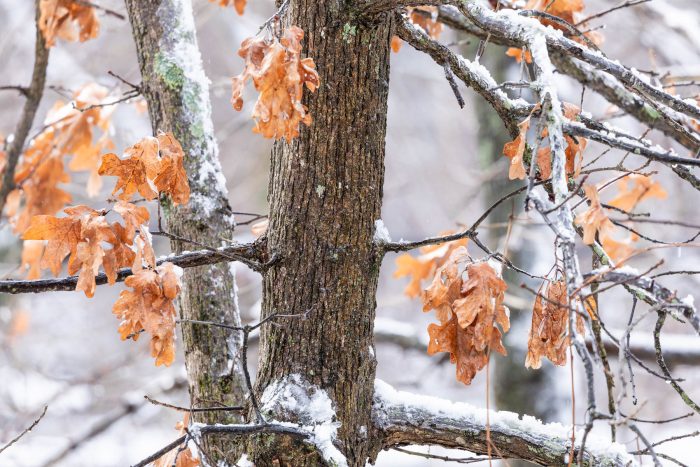White Oak
Quercus alba
The white oak is a large shade tree with light gray furrowed bark and lobed green leaves. It is found throughout the Chesapeake Bay region.
This section shows one large critter image at a time. Use the thumbnails that follow to select a specific image to display here.

This gallery contains a grid of small thumbnails. Selecting a thumbnail will change the main image in the preceding section.
Appearance
Mature white oaks grow to a height and spread of 50 to 80 feet. The bark is a light gray color with shallow furrows that give it a scaly appearance. The tree’s leaves are light green and smooth, with a lighter underside, and they turn red in the fall.
White oak leaves have between seven and nine rounded lobes and are broader at the end than at the base. They are five to nine inches in length and two to 4.5 inches in width.
Predators
Various parts of the tree are eaten by birds, rodents and deer. The white oak is also susceptible to the gypsy moth, an invasive forest pest.
Reproduction and life cycle
White oaks, like all other oak trees, are wind-pollinated. Both male and female flowers grow on the same tree; the male flowers are yellow-green drooping clusters, while the female flowers are small, red and petal-less. The trees can grow one to two feet in height each year.
At age 20, the white oak starts to produce acorns, which are a light green to brown color with a shallow brown cap that covers about one-fourth of the nut. The acorns are thinner and more elongated than those of red or black oaks. The acorns will germinate in autumn, after falling to the ground.
Did you know?
- The white oak is the state tree of Maryland.
- Various parts of the tree are eaten by birds, rodents and deer. The white oak is also susceptible to the spongy moth, an invasive forest pest.
- The largest known white oak tree, which had a trunk circumference of 32 feet, grew in Wye Oak State Park, in Talbot County, Maryland. Unfortunately, the tree was destroyed by a storm in 2002.
- Leaves that grow in the sun tend to have longer lobes, while those that grow in the shade have shallower lobes.
Sources and additional information
- White Oak – Illinois University Museum
- Tree Guide: White Oak – Arbor Day Foundation
- Field Guide to Native Oak Species of Eastern North America: Quercus alba – U.S. Forest Service
- DePauw Nature Park Field Guide: White Oak – DePauw University
